Rachel Feinstein Circles Back Around

Rachel Feinstein is moving in circles. So are you; we all are.
“I feel very out of touch sometimes with contemporary artists who think [they’re] doing something new for the first time,” says Feinstein. “Everything comes from everything else. There’s no way you’re doing anything new. I mean, there’s nothing new,” she adds. “We all keep going around and around and around and infiltrating and layering all the different stuff that came before us. And I want to acknowledge that and use that as a means of moving forward.”
More from WWD
The next stop on the artist’s circuitous route is Florence, where her work is being shown in a career survey alongside Renaissance and Baroque works across three venues — Museo Stefano Bardini, the Palazzo Medici Riccardi, and the Museo Marino Marini. “Rachel Feinstein in Florence” is a full-circle moment for the New York artist, who draws inspiration from fairytales and art history of past centuries.
“Florence is definitely the birthplace to all of my feelings about sculpture,” she says.
Feinstein is seated near the front of her studio space in Tribeca, several days before flying to Italy for the opening of her exhibition, curated by Sergio Risaliti. The show follows a similar exhibition last year that featured painter Jenny Saville’s work. “[Risaliti] is specifically choosing people that historically probably wouldn’t have been able to be anywhere near a Donatello as an artist,” says Feinstein. “But now, that’s where things are getting interesting.”
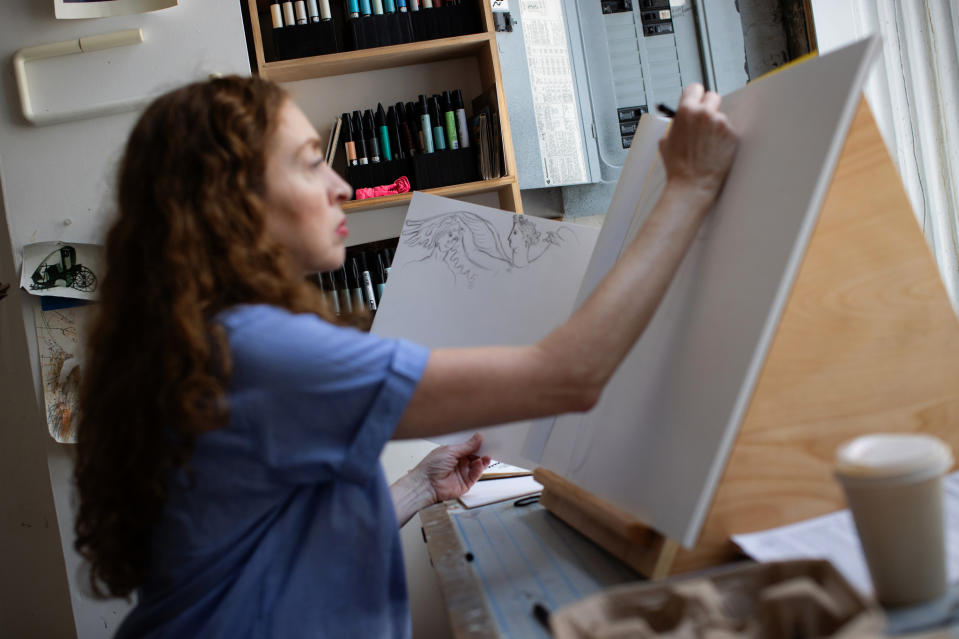
She met Risaliti in Florence around seven years ago when her husband, painter John Currin, was preparing a show with the curator. Feinstein accompanied Currin to Florence for installation, and describes the trip as a formative mid-career experience.
“That time [in Florence] really did transform my life,” she says. “I saw Donatello’s famous David sculpture. And then I saw the Donatello Magdalene sculpture, which is in a different museum in Florence, and I couldn’t believe they were made by the same person,” she adds, describing the textural effects of both: the smooth, polished, wet look of the David, and the dry, wooden, hand-carved, larger-than-life Magdalene.
“I had a visceral experience standing in front of [the sculptures],” she adds. “They were these two opposing sculptures made by the same person. And I got kind of obsessed on this whole thing about dualities.”
That duality shows up in different iterations within her work: how the same sculpture can have different impacts when rendered in various sizes; the friction between high- and low-brow culture within a painting; the ways in which cultural discourse around women can remain very much the same across centuries and different societal landscapes.
To underscore her point, Feinstein compares the impact of past cultural upheavals — like the Gutenberg press — and contemporary advances in media, namely social media. The artist is specifically interested in the female experience and draws the link between technological advancements and their negative impact on girls.
“It’s always been some new thing that has upset humankind. And how do people deal with it?” she says. “Looking at art is the way that I learn how to deal with the craziness that’s going on in our world.”
Then there’s the duality of showing her 21st century work alongside Donatello, Michelozzo, and other Italian “greats.” “Of course it’s frightening to think, God, what if my stuff doesn’t hold up to Donatello? Which is very highly likely, because Donatello is the greatest sculptor of all time,” says Feinstein, who notes that while it’s tempting to romanticize the past, context is important. “No artist alive has the skill set that those guys did. And that’s just the bottom line. John [Currin] and I talk about that all the time. You just have to accept your clumsiness as a contemporary artist, but at the same time, you also have to embrace it: that you’re alive, and they’re dead.”
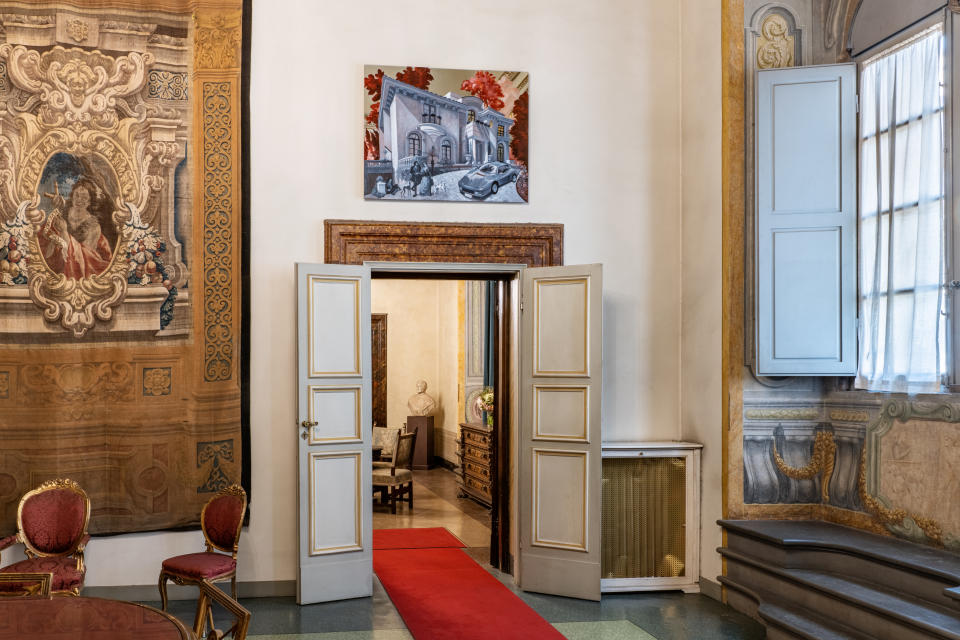
“Rachel Feinstein in Florence” mixes old and new within the artist’s canon and spans more than a decade of her career. “The religious side, the high and low side, and the sculptural forms and the relationships to your body: all of the aspects of my work are coming into [the exhibition],” says Feinstein.
Her oldest works on view are two 2005 painted mirror works, exhibited at Palazzo Medici Riccardi along with several 2018 mirror paintings that mix modern McMansions with swanky scenes inspired by vintage wallpaper motifs.
Much of her work interrogates how women have been represented throughout history. This thread is most prevalent at the Museo Marino Marini, where her first “Angels” sculptures, based on Victoria’s Secret runway models, are exhibited alongside Marini’s 1929 “Dancer” sculpture. Feinstein is also debuting eight new Angel sculptures scaled down and rendered in porcelain at the Museo Stefano Bardini. The various sizes relate to her spatial experience with Donatello’s work and how space can shift the meaning for the viewer.
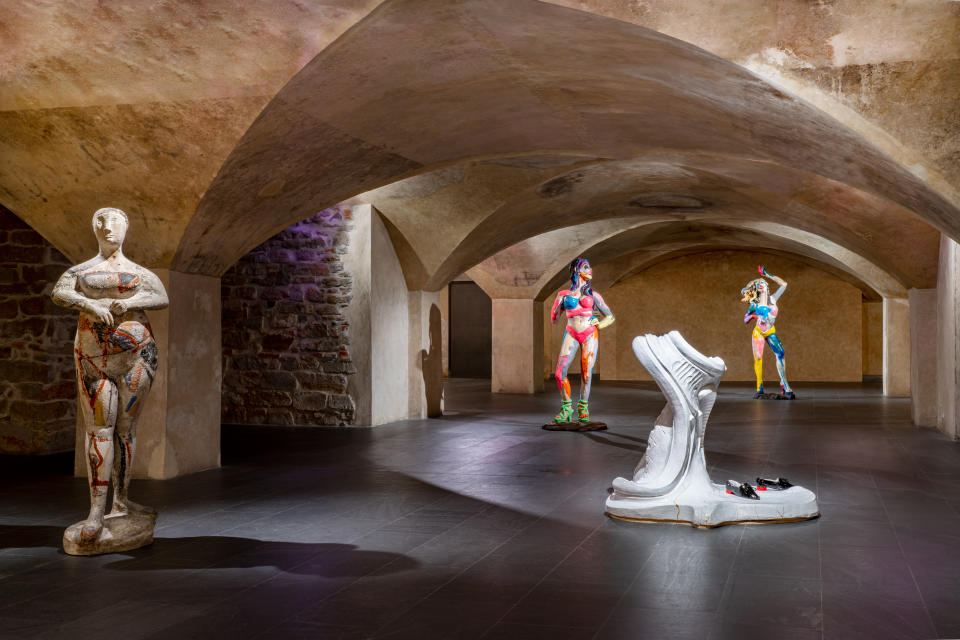
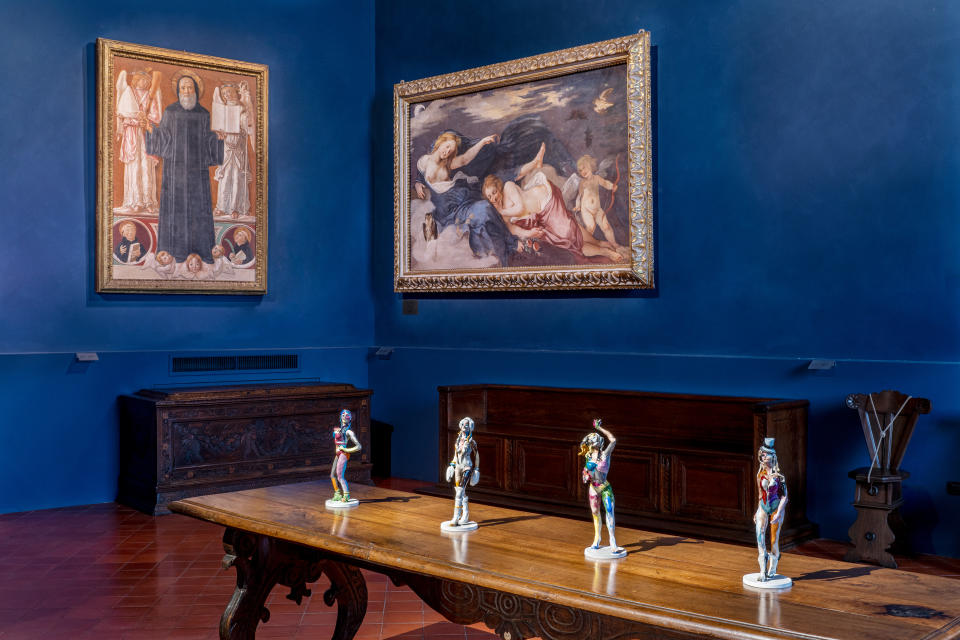
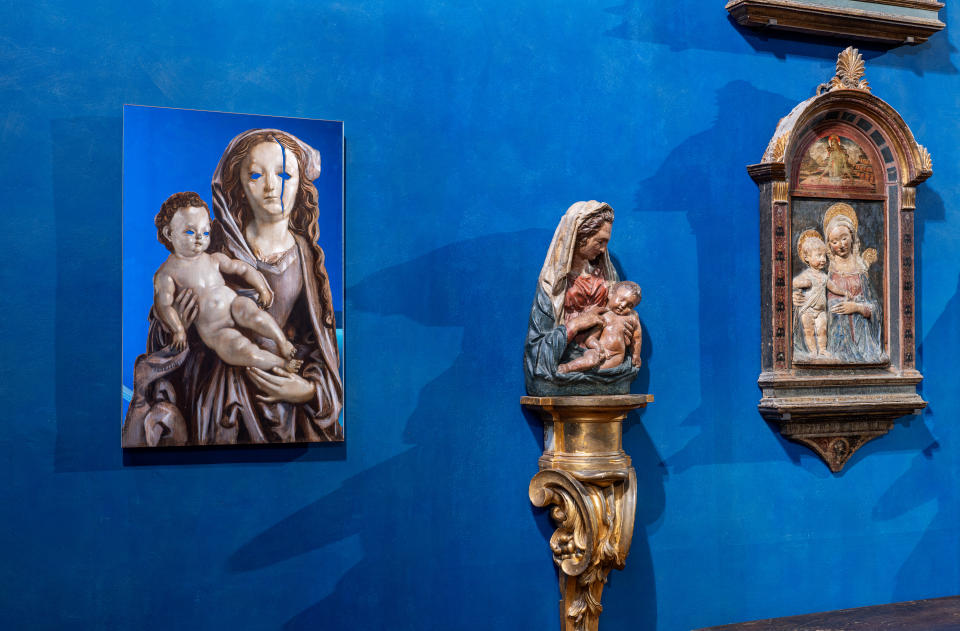
Also at the Bardini is her frenetic wooden puzzle sculpture “St. Agatha,” exhibited next to Antonio del Pollaiuolo’s “St. Michael Archangel” painting. Back in her New York studio, Feinstein turns her attention to her similar sculpture, “Metal Storm,” looming nearby. The piece, from her recent Gagosian show “Mirrors” in London, is a 3D rendering of Hans Baldung Grien’s 1514 painting “New Year’s Greeting With Three Witches.”
“A long time ago, people believed witches were these satanic creatures,” she says. “And all it is is based on the idea that these were women that were healers and that were actually able to do things that men weren’t able to do,” she adds. “[Grien] used the symbol of the sexy witch as a way to sell art as a male artist. And I think, why not do that as a female artist, you know?”
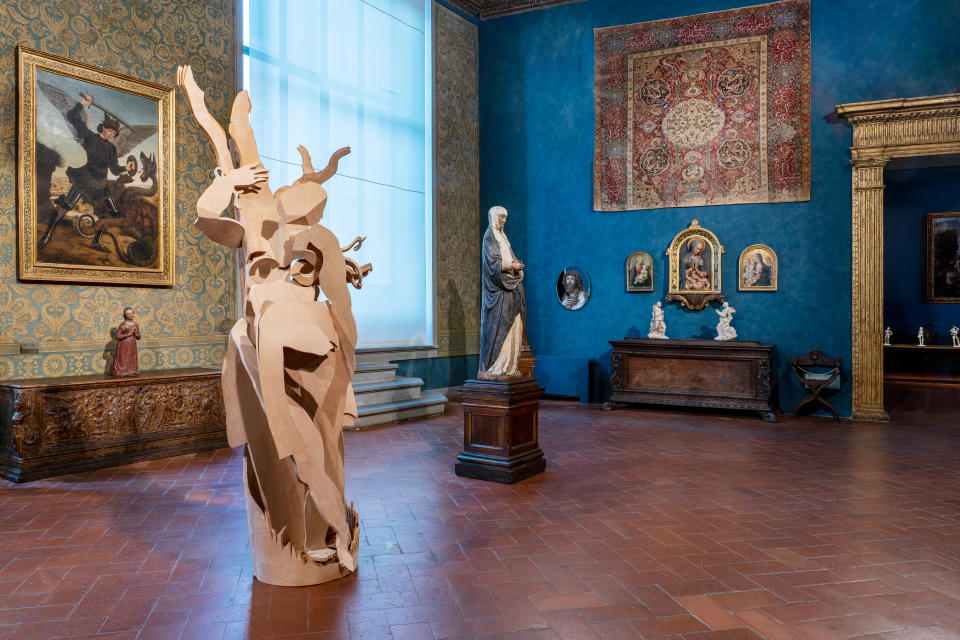
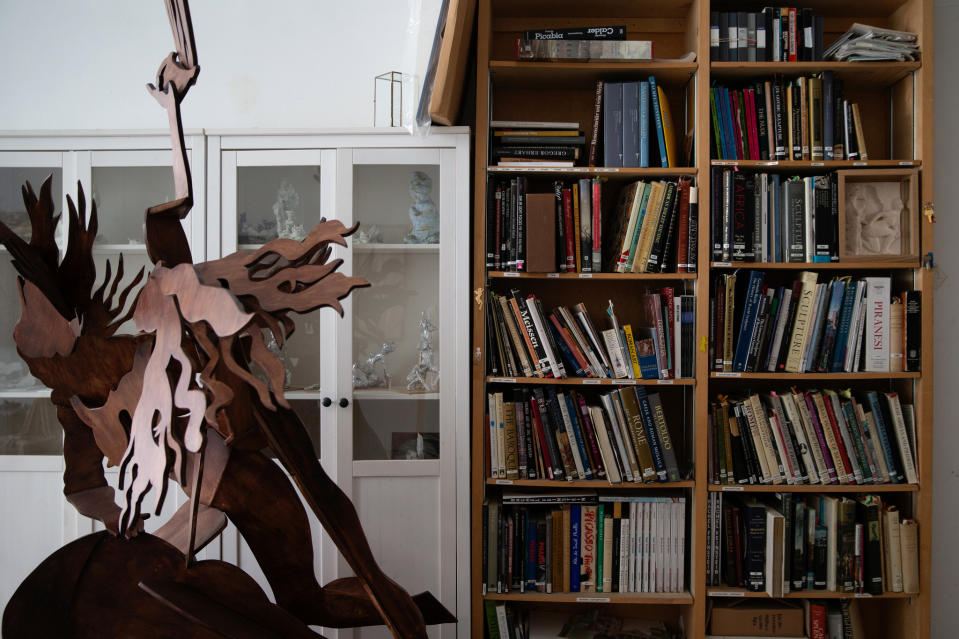
Another full-circle moment in Florence: Gucci is the exhibition’s main sponsor, and in 2019, Feinstein was the brand’s first artist-in-residence at the Chatsworth House in the U.K. Feinstein, who worked as a fashion model when she was a teenager in Miami before moving to New York for college, has maintained a connection to fashion throughout her art career. In 2012, she designed the set for Marc Jacobs’ fall show, which had been partly inspired by her sculpture “Puritan’s Delight.”
“I’ve always felt a connection to people in fashion because first of all, they move much faster,” says Feinstein (her set design for Jacobs was completed in less than two weeks). “And I think that the art world can use a little bit of that sometimes because there’s this idea that it’s always about later. It’s always about, what is this art piece going to be worth 20 years from now, or 30 years now? What is it gonna say? And sometimes you get so hung up on that it makes you constipated, you get stuck.”
At the moment, the walls of her studio are lined with relief works-in-progress depicting erotic scenes; Feinstein isn’t sure where the series is headed yet, but two pieces will be shown at Art Basel in Switzerland this month.
Later this summer, Feinstein will decamp to her studio space in Maine, and in the fall, she plans to head to Miami to start planning her 2024 solo exhibition at the Bass Museum. It will be her first significant institutional show in her hometown, where she first got a glimpse of the creative life that awaited her in New York. Back then, she was the subject of other creatives; now, she’s the visionary.
“It all keeps coming back in a circle, like I tell you,” she says.
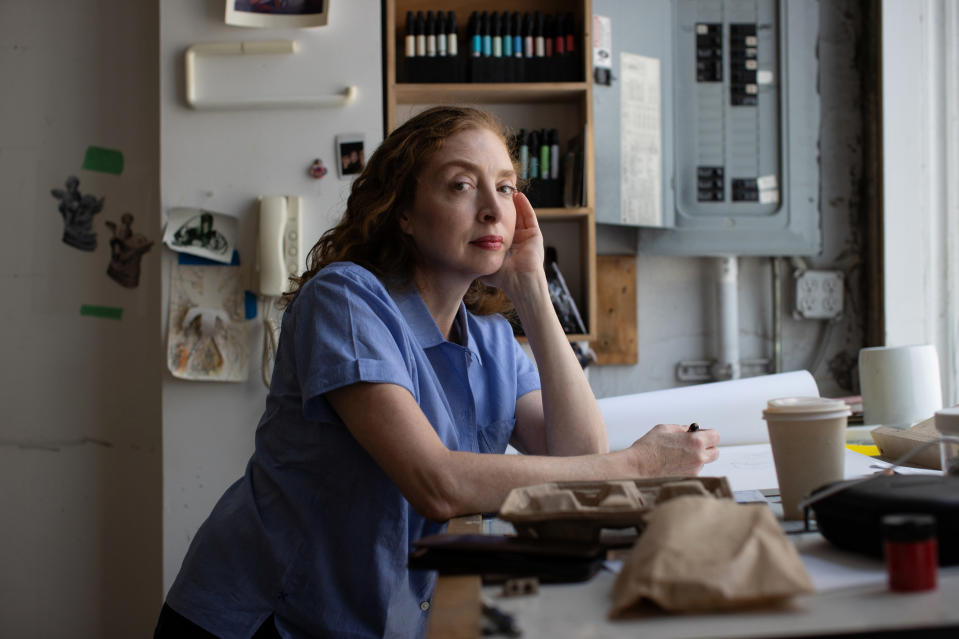
Launch Gallery: Inside Rachel Feinstein's Studio
Best of WWD

